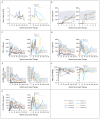Efficacy of gene therapy for X-linked severe combined immunodeficiency
- PMID: 20660403
- PMCID: PMC2957288
- DOI: 10.1056/NEJMoa1000164
Efficacy of gene therapy for X-linked severe combined immunodeficiency
Abstract
Background: The outcomes of gene therapy to correct congenital immunodeficiencies are unknown. We reviewed long-term outcomes after gene therapy in nine patients with X-linked severe combined immunodeficiency (SCID-X1), which is characterized by the absence of the cytokine receptor common gamma chain.
Methods: The nine patients, who lacked an HLA-identical donor, underwent ex vivo retrovirus-mediated transfer of gamma chain to autologous CD34+ bone marrow cells between 1999 and 2002. We assessed clinical events and immune function on long-term follow-up.
Results: Eight patients were alive after a median follow-up period of 9 years (range, 8 to 11). Gene therapy was initially successful at correcting immune dysfunction in eight of the nine patients. However, acute leukemia developed in four patients, and one died. Transduced T cells were detected for up to 10.7 years after gene therapy. Seven patients, including the three survivors of leukemia, had sustained immune reconstitution; three patients required immunoglobulin-replacement therapy. Sustained thymopoiesis was established by the persistent presence of naive T cells, even after chemotherapy in three patients. The T-cell-receptor repertoire was diverse in all patients. Transduced B cells were not detected. Correction of the immunodeficiency improved the patients' health.
Conclusions: After nearly 10 years of follow-up, gene therapy was shown to have corrected the immunodeficiency associated with SCID-X1. Gene therapy may be an option for patients who do not have an HLA-identical donor for hematopoietic stem-cell transplantation and for whom the risks are deemed acceptable. This treatment is associated with a risk of acute leukemia. (Funded by INSERM and others.)
2010 Massachusetts Medical Society
Figures


Similar articles
-
Sustained correction of X-linked severe combined immunodeficiency by ex vivo gene therapy.N Engl J Med. 2002 Apr 18;346(16):1185-93. doi: 10.1056/NEJMoa012616. N Engl J Med. 2002. PMID: 11961146 Clinical Trial.
-
Lentiviral Gene Therapy Combined with Low-Dose Busulfan in Infants with SCID-X1.N Engl J Med. 2019 Apr 18;380(16):1525-1534. doi: 10.1056/NEJMoa1815408. N Engl J Med. 2019. PMID: 30995372 Free PMC article. Clinical Trial.
-
Gene therapy of X-linked severe combined immunodeficiency by use of a pseudotyped gammaretroviral vector.Lancet. 2004 Dec 18-31;364(9452):2181-7. doi: 10.1016/S0140-6736(04)17590-9. Lancet. 2004. PMID: 15610804
-
Immune Reconstitution After Gene Therapy Approaches in Patients With X-Linked Severe Combined Immunodeficiency Disease.Front Immunol. 2020 Nov 27;11:608653. doi: 10.3389/fimmu.2020.608653. eCollection 2020. Front Immunol. 2020. PMID: 33329605 Free PMC article. Review.
-
[Transplantation of genetically modified cells in the treatment of children with SCID: great hopes and recent disappointments].Med Wieku Rozwoj. 2003 Jan-Mar;7(1):27-34. Med Wieku Rozwoj. 2003. PMID: 13130167 Review. Polish.
Cited by
-
Bone marrow-derived microglia-based neurturin delivery protects against dopaminergic neurodegeneration in a mouse model of Parkinson's disease.Neurosci Lett. 2013 Feb 22;535:24-9. doi: 10.1016/j.neulet.2012.12.034. Epub 2013 Jan 4. Neurosci Lett. 2013. PMID: 23295906 Free PMC article.
-
Viscous Core Liposomes Increase siRNA Encapsulation and Provides Gene Inhibition When Slightly Positively Charged.Pharmaceutics. 2021 Apr 1;13(4):479. doi: 10.3390/pharmaceutics13040479. Pharmaceutics. 2021. PMID: 33916066 Free PMC article.
-
Role of transgene regulation in ex vivo lentiviral correction of artemis deficiency.Hum Gene Ther. 2015 Apr;26(4):232-43. doi: 10.1089/hum.2014.062. Epub 2015 Apr 13. Hum Gene Ther. 2015. PMID: 25738323 Free PMC article.
-
Evaluating risks of insertional mutagenesis by DNA transposons in gene therapy.Transl Res. 2013 Apr;161(4):265-83. doi: 10.1016/j.trsl.2012.12.005. Epub 2013 Jan 10. Transl Res. 2013. PMID: 23313630 Free PMC article. Review.
-
High efficiency restriction enzyme-free linear amplification-mediated polymerase chain reaction approach for tracking lentiviral integration sites does not abrogate retrieval bias.Hum Gene Ther. 2013 Jan;24(1):38-47. doi: 10.1089/hum.2012.082. Epub 2012 Oct 26. Hum Gene Ther. 2013. PMID: 22992116 Free PMC article.
References
-
- Sugamura K, Asao H, Kondo M, et al. The interleukin-2 receptor gamma chain: its role in the multiple cytokine receptor complexes and T cell development in XSCID. Annu Rev Immunol. 1996;14:179–205. - PubMed
-
- Leonard WJ. Cytokines and immunodeficiency diseases. Nat Rev Immunol. 2001;1:200–8. - PubMed
-
- Noguchi M, Yi H, Rosenblatt HM, et al. Interleukin-2 receptor gamma chain mutation results in X-linked severe combined immunodeficiency in humans. Cell. 1993;73:147–57. - PubMed
-
- Buckley RH, Schiff SE, Schiff RI, et al. Hematopoietic stem-cell transplantation for the treatment of severe combined immunodeficiency. N Engl J Med. 1999;340:508–16. - PubMed
-
- Antoine C, Müller S, Cant A, et al. Long-term survival and transplantation of haemopoietic stem cells for immunodeficiencies: report of the European experience 1968–99. Lancet. 2003;361:553–60. - PubMed
Publication types
MeSH terms
Substances
Grants and funding
LinkOut - more resources
Full Text Sources
Other Literature Sources
Medical
Research Materials
